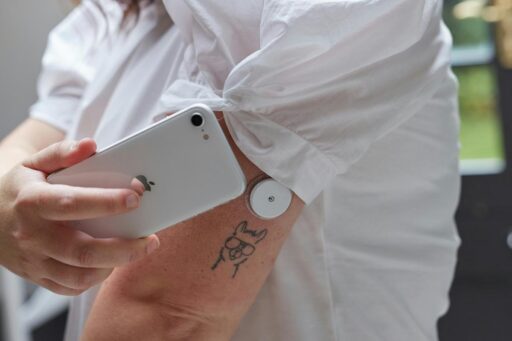CGM for Non Diabetics: Biohack or Bust?
Healthy’s Summary
Continuous glucose monitors (CGMs) aren’t just for people with diabetes anymore. More and more health-conscious folks are using CGM for non diabetics to track blood sugar patterns, optimize energy, improve workouts, and even slow aging. But does it actually work—or is it just another wellness trend wrapped in expensive tech?
We’ll break down what CGMs really do, why non-diabetics are reaching for them, and whether tracking your glucose (when you don’t technically “need to”) can actually help you live longer or feel better day to day.
Spoiler alert: The science is still catching up, but the personal insights? Pretty fascinating.
How Could CGM For Non Diabetics Be Useful?
The idea behind continuous glucose monitoring (CGM) for non diabetics is simple: if blood sugar affects your energy, mood, sleep, and long-term health (spoiler: it does), then maybe watching those ups and downs in real-time could help you make smarter choices.
Here’s how it works: a small sensor sits under your skin, measuring glucose 24/7. You pair it with an app and—voila!—you’ve got a window into how your body reacts to everything from oatmeal to HIIT workouts to stress at work.
Originally designed to help people with type 1 or type 2 diabetes manage insulin levels, CGMs are now showing up on arms of athletes, biohackers, and wellness-curious folks who want to:
- Spot glucose spikes from specific meals
- Track how sleep or stress changes blood sugar
- Fine-tune their diet for steadier energy
- Potentially reduce inflammation and insulin resistance over time
What Does a CGM Actually Tell You?
The appeal of a CGM for non diabetics isn’t really about diagnosing anything. It’s more like a mirror for your metabolic health.
Here’s what you can see:
- How high your glucose goes after a meal (the spike)
- How quickly it comes back down (the recovery)
How stable your levels are while fasting or sleeping - Whether certain foods or patterns are consistently disruptive
But what you can’t see? A clear roadmap. CGM data isn’t one-size-fits-all. For someone without diabetes, a “spike” might not be dangerous—it might just mean you ate fast carbs after a workout (and that’s okay!).
Still, the personal data can feel empowering. Some users report less brain fog, more consistent energy, and even better sleep once they identify and adjust the habits that throw their glucose off track.
The caveat: It takes a little effort to interpret the trends, and CGMs aren’t cheap (often $100–$300/month without insurance).
Is This the Future of Longevity Tracking?
Here’s where things get interesting. A lot of the hype around CGM for non diabetics comes from the longevity crowd—people trying to extend lifespan and healthspan.
They argue that steady glucose levels may reduce chronic inflammation and insulin resistance, two sneaky contributors to aging and disease. There’s also some early data suggesting glycemic variability (aka sugar swings) might be tied to cardiovascular risk, even in non-diabetics. But again, the key word is early.
Some studies suggested that glucose levels could predict biological age more accurately than some other biomarkers. But most research still focuses on people with existing metabolic issues.
In short: Using a CGM might help you notice early signs of metabolic imbalance, which could let you course-correct sooner. But it’s not a guarantee of longevity. Think of it like a flashlight, not a magic wand.
Ask Healthy
Is CGM For Non Diabetics Worth Trying?
That depends on what you’re hoping to learn. If you’re curious about how your body handles sugar, want to experiment with food timing, or just love nerding out over data, a CGM can be incredibly eye-opening.
Just remember: it’s not a wellness panacea. It won’t fix poor sleep, chronic stress, or an ultra-processed diet. And it’s not always easy to interpret the data without support.
A few tips if you’re thinking about trying it:
- Look for apps or platforms that help non-diabetics understand their data
- Give yourself at least two weeks of wear time to spot patterns
- Don’t panic over one high reading—context is everything
- Use what you learn to build habits, not rules
Also worth noting: some nutritionists and doctors express concern that hyper-focusing on glucose could lead to food anxiety or disordered eating in some people. So if you’ve had a complicated relationship with food, talk to a professional first.
Still wondering if a CGM is right for you? Our other article Is Continuous Glucose Monitoring Worth It If You’re Not Diabetic? is a great resource.
The Takeaway
CGM for non diabetics is a rising trend with some intriguing potential. It won’t replace a balanced lifestyle, but it might give you new insight into how your body responds to what you eat, how you move, and how you sleep. And if it helps you feel more in tune with your own biology? That’s a win.
Just go in with curiosity, not perfectionism.
Want to dig deeper?
AgeProof: Optimize Health Today for a Longer, Stronger Tomorrow
Engaging conversations provide science-backed insights, tools, and actionable guidance to help optimize physical health, mental resilience, and lifestyle habits that are proven to support longevity. You can explore topics like nutrition, exercise, cognitive health, sleep optimization, and stress management. Key features include personalized discussions on building resilience, reducing chronic disease risk, and managing lifestyle factors essential for healthy aging. Whether setting achievable health goals, understanding genetics, or refining routines, this program serves as a supportive guide for anyone looking to invest in a healthier, more vibrant future.
Enroll in one of Healthy’s Programs to log, track and learn more about your Health, one conversation at a time.
Learn More




